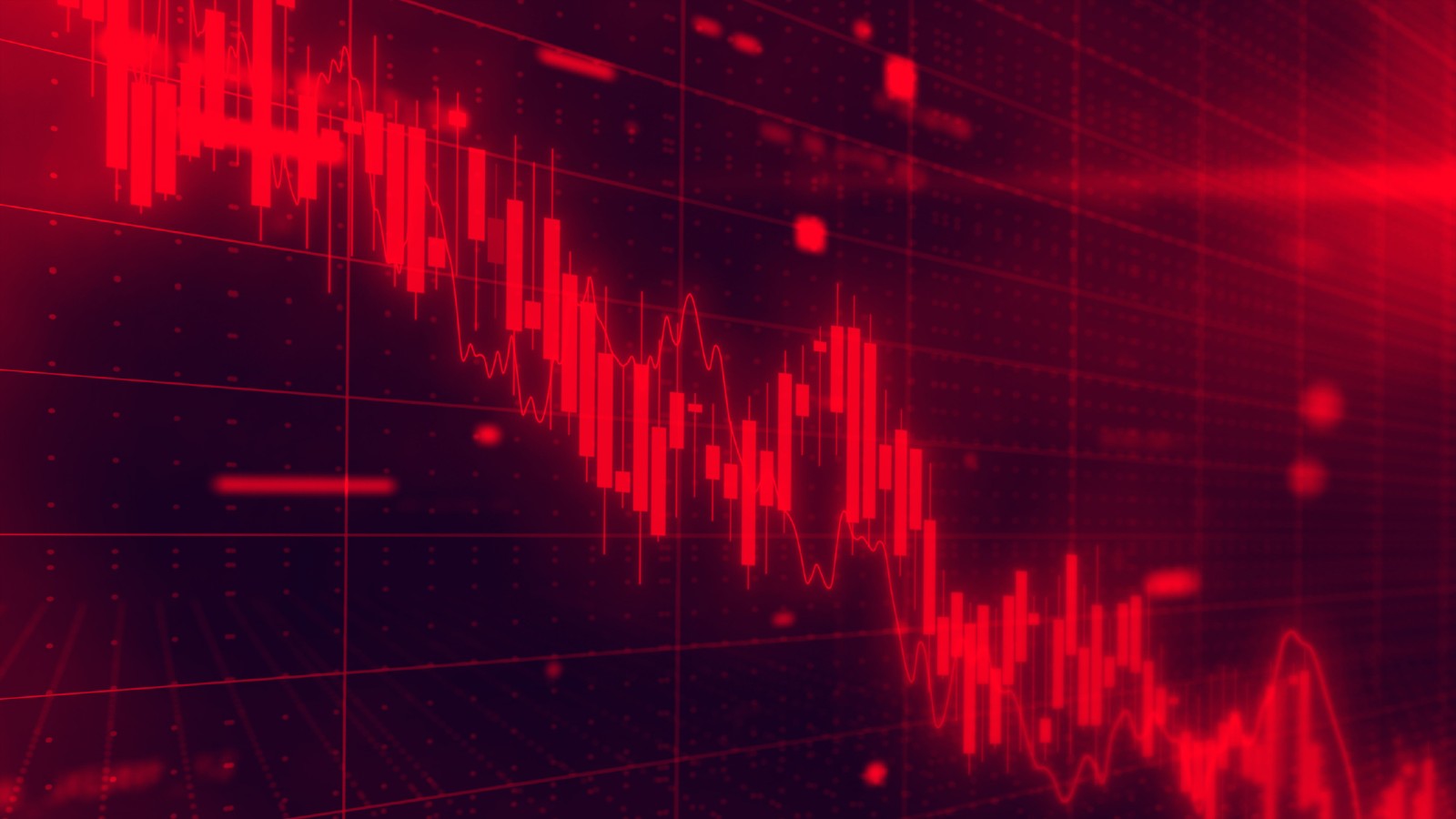Stock Market Today: Dow Sinks 611 Points on Rising Recession Fears
A weak July jobs report sent stocks tumbling on worries the Fed is behind the curve on rate cuts.


Joey Solitro
The sharp selloff in stocks accelerated Friday as weak hiring and rising unemployment sparked a race out of risk assets. The Magnificent 7 stocks that have contributed the majority of the bull market's gains led equities lower, with the Nasdaq-100 entering correction territory.
Equities are off to a terrible start in August as a series of weaker readings on the labor market and other mixed economic news have market participants increasingly anxious that the Federal Reserve waited too long to bring interest rates down from a 23-year high. Friday's surprisingly weak July jobs report only intensified those concerns.
U.S. nonfarm payrolls expanded by 114,000 last month, the Bureau of Labor Statistics said Friday, or well below economists' forecast for the creation of 175,000 jobs. Over the past year, the U.S. economy created an average of 215,000 jobs per month. Additionally, the soft June jobs report was revised lower by 27,000 jobs to 179,000.

Sign up for Kiplinger’s Free E-Newsletters
Profit and prosper with the best of expert advice on investing, taxes, retirement, personal finance and more - straight to your e-mail.
Profit and prosper with the best of expert advice - straight to your e-mail.
The unemployment rate, which is derived from a separate survey, ticked up to 4.3% in July from 4.1% the prior month. The rise in unemployment triggered the Sahm Rule, a recession indicator with a perfect track record over the past 50 years.
"July's poor employment report leaves the Fed looking woefully behind the curve with its decision to hold rates this week, and suggests that the outcome of September's meeting now is finely balanced between quarter-point and half-point easings," writes Ian Shepherdson, chairman and chief economist Pantheon Macroeconomics. "The weakness was broad-based and unattributable to one-time factors, such as the weather: the long-lagged effect of excessively tight monetary policy is to blame."
A weakening labor market puts increasing pressure on the Federal Reserve's rate-setting group, the Federal Open Market Committee (FOMC), to lower the short-term federal funds rate at the next Fed meeting.
As of August 2, futures traders assigned an 80% probability to the FOMC enacting a half-point cut in September, up from 22% a day ago, according to CME Group's FedWatch Tool. At the same time, the odds of the Fed making a quarter-point cut at its next meeting dropped to 20% from 78% a day ago.
"Risk assets are getting hammered on joblessness worries, and investors are no longer reacting favorably to negative economic developments," writes José Torres, senior economist at Interactive Brokers. "Equity indices are selling off across the board."
By the closing bell, the blue-chip Dow Jones Industrial Average shed 611 points, or 1.5%, to finish at 39,737. The tech-heavy Nasdaq Composite tumbled 2.4% to 16,776, while the broader S&P 500 fell 1.8% to close at 5,346.
Stocks on the move
Mixed-to-disappointing earnings from Big Tech names also have markets recalibrating their bets on all things AI. Earnings season has revealed that massive capital spending on generative AI may not prove profitable as soon as previously thought.
Amazon.com (AMZN) stock fell 8.8% after the world’s largest e-commerce company reported mixed earnings results for its second quarter and issued an outlook for the third quarter that fell just short of expectations.
But Wall Street doesn't seem too worried about the results. "Amazon's artificial intelligence (AI) initiatives continue to be deep, broad, well-adopted and supported," says Aron Bohlig, managing partner at ComCap. "AI and advanced technology investments include: chips, major partnerships with NVIDIA, many major model enhancements, programming interfaces, robots and robotic taxis."
When combining these AI initiatives with "Amazon's entertainment, healthcare and grocery products, the company really is a single source for most consumer's major needs and its position in these markets continues to improve," Bohlig adds.
Elsewhere, Apple (AAPL) stock rose 0.7% after the technology giant reported better-than-expected earnings results for its fiscal third quarter and hinted at similar growth in its fiscal fourth quarter.
In the three months ended June 29, Apple's revenue increased 4.9% year-over-year to $85.8 billion, driven by 14.1% growth in services to $24.2 billion. Its earnings per share (EPS) improved 11.1% from the year-ago period to $1.40.
"During the quarter, our record business performance generated EPS growth of 11 percent and nearly $29 billion in operating cash flow, allowing us to return over $32 billion to shareholders," said Apple Chief Financial Officer Luca Maestri in a statement. "We are also very pleased that our installed base of active devices reached a new all-time high in all geographic segments, thanks to very high levels of customer satisfaction and loyalty."
Intel failure
Intel (INTC) stock plunged 26% after the chipmaker missed top- and bottom-line expectations for its second quarter and provided a weak outlook for its third quarter.
To make matters worse, as part of its efforts to cut costs, Intel said it is reducing its headcount by 15% and temporarily eliminating its dividend.
"Intel is taking the added step of suspending the dividend starting in the fourth quarter, recognizing the importance of prioritizing liquidity to support the investments needed to execute its strategy," the company said. However, Intel noted that it has "a long-term commitment to a competitive dividend as cash flows improve to sustainably higher levels."
INTC suffered its worst session in half a century to close at levels last seen more than 10 years ago. The once mighty tech titan has been a catastrophe for buy-and-hold investors. Indeed, anyone who put $1,000 into Intel stock 20 years ago should be horrified by what the investment is worth today.
Related content
- The Fed Is About to Cut Rates. What Should Investors Do?
- If You'd Put $1,000 Into Amazon Stock 20 Years Ago, Here's What You'd Have Today
- Stocks With the Highest Dividend Yields in the S&P 500
Get Kiplinger Today newsletter — free
Profit and prosper with the best of Kiplinger's advice on investing, taxes, retirement, personal finance and much more. Delivered daily. Enter your email in the box and click Sign Me Up.

Dan Burrows is Kiplinger's senior investing writer, having joined the publication full time in 2016.
A long-time financial journalist, Dan is a veteran of MarketWatch, CBS MoneyWatch, SmartMoney, InvestorPlace, DailyFinance and other tier 1 national publications. He has written for The Wall Street Journal, Bloomberg and Consumer Reports and his stories have appeared in the New York Daily News, the San Jose Mercury News and Investor's Business Daily, among many other outlets. As a senior writer at AOL's DailyFinance, Dan reported market news from the floor of the New York Stock Exchange.
Once upon a time – before his days as a financial reporter and assistant financial editor at legendary fashion trade paper Women's Wear Daily – Dan worked for Spy magazine, scribbled away at Time Inc. and contributed to Maxim magazine back when lad mags were a thing. He's also written for Esquire magazine's Dubious Achievements Awards.
In his current role at Kiplinger, Dan writes about markets and macroeconomics.
Dan holds a bachelor's degree from Oberlin College and a master's degree from Columbia University.
Disclosure: Dan does not trade individual stocks or securities. He is eternally long the U.S equity market, primarily through tax-advantaged accounts.
- Joey SolitroContributor
-
 Two Don'ts and Four Dos During Trump's Trade War
Two Don'ts and Four Dos During Trump's Trade WarThe financial rules have changed now that tariffs have disrupted the markets and created economic uncertainty. What can you do? (And what shouldn't you do?)
By Maggie Kulyk, CRPC®, CSRIC™
-
 I'm Single, With No Kids: Why Do I Need an Estate Plan?
I'm Single, With No Kids: Why Do I Need an Estate Plan?Unless you have a plan in place, guess who might be making all the decisions about your prized possessions, or even your health care: a court.
By Cynthia Pruemm, Investment Adviser Representative
-
 Two Don'ts and Four Dos During Trump's Trade War
Two Don'ts and Four Dos During Trump's Trade WarThe financial rules have changed now that tariffs have disrupted the markets and created economic uncertainty. What can you do? (And what shouldn't you do?)
By Maggie Kulyk, CRPC®, CSRIC™
-
 I'm Single, With No Kids: Why Do I Need an Estate Plan?
I'm Single, With No Kids: Why Do I Need an Estate Plan?Unless you have a plan in place, guess who might be making all the decisions about your prized possessions, or even your health care: a court.
By Cynthia Pruemm, Investment Adviser Representative
-
 Most Investors Aren't as Diversified as They Think: Are You?
Most Investors Aren't as Diversified as They Think: Are You?You could be facing a surprisingly dangerous amount of concentration risk without realizing it. Fixing that problem starts with knowing exactly what you own.
By Scott Noble, CPA/PFS
-
 My First $1 Million: Literacy Interventionist, 59, Colorado
My First $1 Million: Literacy Interventionist, 59, ColoradoEver wonder how someone who's made a million dollars or more did it? Kiplinger's new My First $1 Million series uncovers the answers.
By Joyce Lamb
-
 Will My Children Inherit Too Much?
Will My Children Inherit Too Much?If you worry about how your children will handle an inheritance, you're not alone. Luckily, you have options — from lifetime gifting to trusts — that can help.
By Mallon FitzPatrick, CFP®, AEP®, CLU®
-
 Charitable Giving Lessons From Netflix's 'Apple Cider Vinegar'
Charitable Giving Lessons From Netflix's 'Apple Cider Vinegar'Charity fraud is rife, and a Netflix series provides a timely warning about donating money to a good cause without looking into its background.
By Peter J. Klein, CFA®, CAP®, CSRIC®, CRPS®
-
 What Happens To Mortgage and Savings Rates If Trump Fires Jerome Powell?
What Happens To Mortgage and Savings Rates If Trump Fires Jerome Powell?President Donald Trump expressed his desire to remove Fed Chair Jerome Powell. If the president is successful, how would it impact your savings accounts?
By Sean Jackson
-
 Why You Need a Trusted Contact for Your Brokerage
Why You Need a Trusted Contact for Your BrokerageYour brokerage or bank needs someone to reach out to if it's concerned you're experiencing fraud or cognitive decline. That's where a trusted contact can help.
By John Waggoner